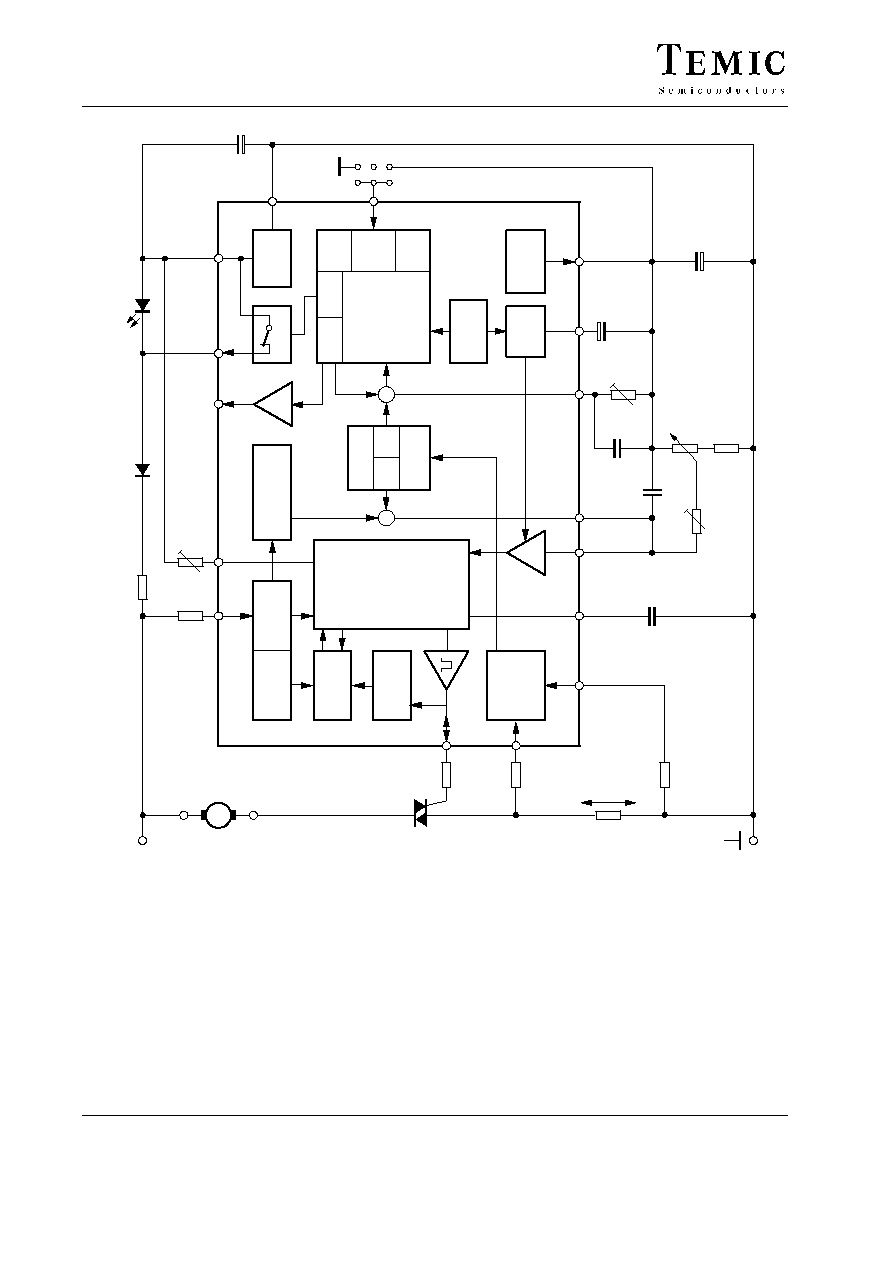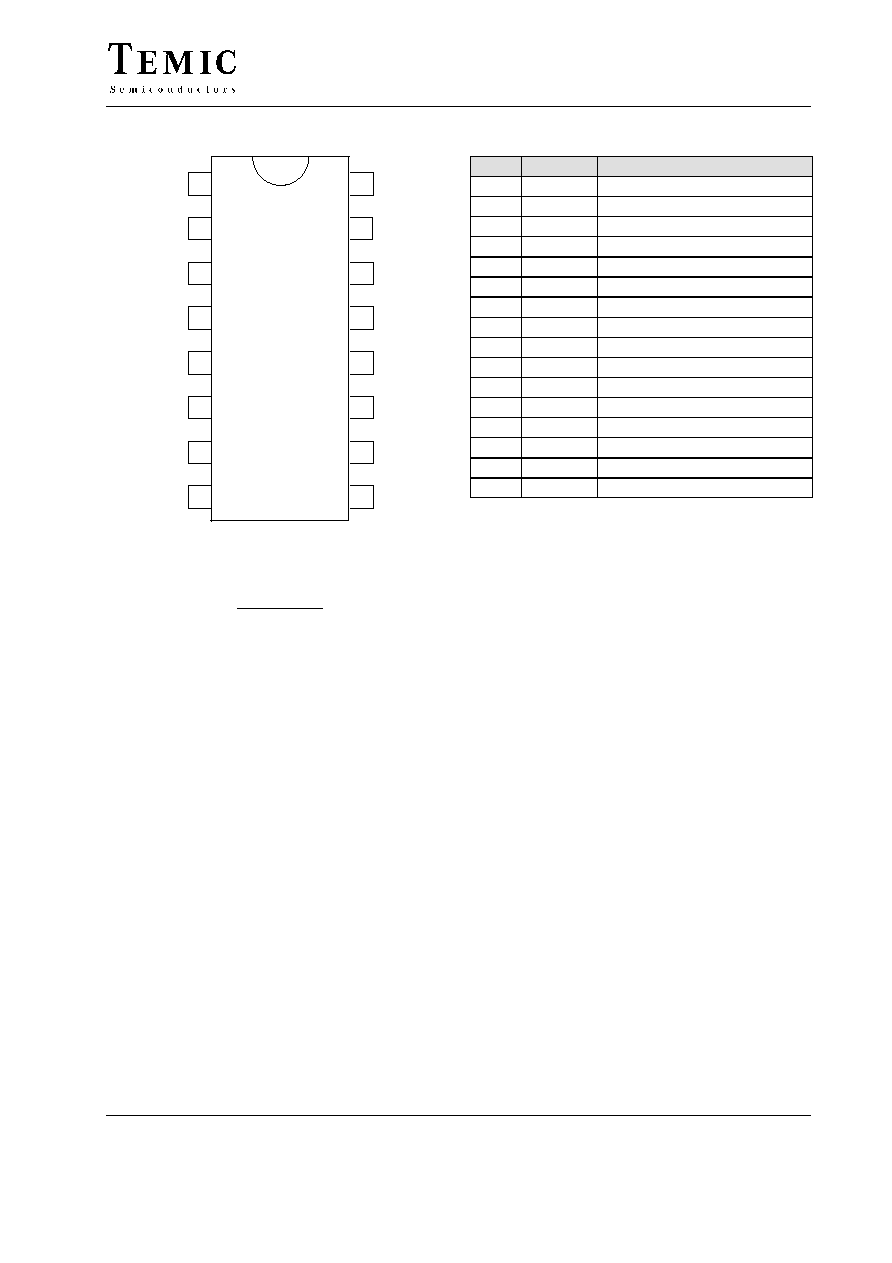 | –≠–ª–µ–∫—Ç—Ä–æ–Ω–Ω—ã–π –∫–æ–º–ø–æ–Ω–µ–Ω—Ç: U2010B | –°–∫–∞—á–∞—Ç—å:  PDF PDF  ZIP ZIP |

U2010B
TELEFUNKEN Semiconductors
Rev. A1, 28-May-96
1 (12)
Phase Control Circuit for Current Feedback
Description
The U2010B is designed as a phase-control circuit in
bipolar technology. It enables load-current detection and
has a soft-start function as well as reference voltage
output. Motor control with load-current feedback and
overload protection are preferred applications.
Features
D Full wave current sensing
D Mains supply variation compensated
D Programmable load-current limitation
with over- and high-load output
D Variable soft-start
D Voltage and current synchronization
D Automatic retriggering switchable
D Triggering pulse typical 125 mA
D Internal supply voltage monitoring
D Current requirement v 3 mA
D Temperature compensated reference voltage
Applications
D Advanced motor control
D Grinder
D Drilling machine
Package: DIP16, SO16
Block Diagram
96 11646
Automatic
retriggering
Limiting
detector
Current
detector
Voltage
detector
15
Phase
control unit
ˆ = f (V
4
)
Mains voltage
compensation
Reference
voltage
Voltage
monitoring
2
4
1
16
Load
current
detector
Full wave
rectifier
1
2
Output
+
Programmable
overload
protection
a
max
Auto≠
start
B
A
I
max
C
100%
70%
Level
shift
Supply
voltage
High load
Soft
start
14
13
12
11
10
9
3
5
6
7
8
≠
Overload
GND
Pulse
output
Figure 1. Block diagram

U2010B
TELEFUNKEN Semiconductors
Rev. A1, 28-May-96
2 (12)
m
0.1 F
96 1
1647
Automatic
retriggering
Limiting
detector
Current
detector
V
oltage
detector
15
Phase
control unit
= f (V
4
)
Mains voltage
compensation
Reference
voltage
V
oltage
monitoring
24
1
16
Load
current
detector
≠
Full wave
rectifier
1
2
Output
+
Programmable
overload
protection
max
Auto≠
start
B
A
I
max
C
100%
70%
Level
shift
Supply
voltage
High load
Soft
start
14
13
12
11
10
9
3
5
67
8
180
W
R
3
TIC
226
Load
R
6
230 V
~
3.3 k
W
R
4
^ V
(R6)
= 250
mV
3.3 k
R
5
Set point
C
3
10 nF
P
1
50 k
W
R
7
8.2 k
W
R
11
1 M
W
Overload
threshold
C
5
R
10
100 k
W
Load current
compensation
0.15 F
C
4
C
2
C
7
1 F
R
8
470 k
W
max
R
2
330 k
W
18 k
W
/2 W
R
1
D
1
BYT51K
D
3
LED
V
S
C
1
Mode
A
B
C
S
1
4.7 F
m
22 F
m
m
m
$
W
Overload
GND
a
a
ˆ
Figure 2. Block diagram with external circuit
General Description
Mains Supply
The U2010B contains voltage limiting and can be
connected with the mains supply via D
1
and R
1
. Supply
voltage
* between Pin 10 and Pin 11 * is smoothed
by C
1
.
In the case of V
6
v (70% of overload threshold voltage),
Pins
11 and 12 are connected internally whereby
V
sat
v 1.2 V. When
V
6
w
V
T70
, the supply current
flows across D
3
.

U2010B
TELEFUNKEN Semiconductors
Rev. A1, 28-May-96
3 (12)
Pin Description
1
2
3
4
5
6
7
8
16
15
14
13
12
11
10
9
C
ˆ
Control
95 11406
Comp.
I
Load
C
soft
V
Ref
I
sense
I
sense
V
R
ˆ
Overload
High load
V
S
GND
Mode
Output
V
Sync.
Pin
Symbol
Function
1
I
sense
Load current sensing
2
I
sense
Load current sensing
3
C
ˆ
Ramp voltage
4
Control
Control input
5
Comp.
Compensation output
6
I
Load
Load current limitation
7
C
soft
Soft start
8
V
Ref
Reference voltage
9
Mode
Mode selection
10
GND
Ground
11
V
S
Supply voltage
12
High load
High load indication
13
Overload
Overload indication
14
V
R
ˆ
Ramp current adjust
15
V
Sync.
Voltage synchronization
16
Output
Trigger output
Series resistance R
1
can be calculated as follows:
R
1max
+
V
mains
≠ V
Smax
2
I
tot
whereas
V
mains
+ Mains supply voltage
V
Smax
+ Maximum supply voltage
I
tot
+ Total current consumption = I
Smax
)I
x
I
Smax
+ Maximum current consumption of the IC
I
x
+ Current consumption of the
external components
Voltage Monitoring
As the voltage is built up, uncontrolled output pulses are
avoided by internal voltage monitoring. Apart from that
all the latches in the circuit (phase control, load limit
regulation) are reset and the soft-start capacitor is short
circuited. This guarantees a specified start-up behavior
each time the supply voltage is switched on or after short
interruptions of the mains supply. Soft-start is initiated
after the supply voltage has been built up. This behavior
guarantees a gentle start-up for the motor and auto-
matically ensures the optimum run-up time.
Phase Control
The function of the phase control is largely identical to the
well known IC family U211B. The phase angle of the
trigger pulse is derived by comparing the ramp voltage V
3
which is mains synchronized by the voltage detector with
the set value on the control input, Pin 4. The slope of the
ramp is determined by C
ˆ
and its charging current I
ˆ
. The
charging current can be varied using R
ˆ
at Pin 14. The
maximum phase angle,
max,
can also be adjusted by
using R
ˆ
(minimum current flow angle
ˆ
min
) see figure 4.
When the potential on Pin 3 reaches the set point level of
Pin 4, a trigger pulse width, t
p
, is determined from the
value of C
ˆ
(t
p
= 9
ms/nF). At the same time, a latch is set
with the output pulse, as long as the automatic
retriggering has not been activated, then no more pulses
can be generated in that half cycle. Control input at Pin 4
(with respect to Pin 10) has an active range from
V
8
to ≠1 V. When V
4
= V
8
, then the phase angle is at its
maximum,
max,
i.e., the current flow angle is minimum.
The minimum phase angle,
min,
is set with V
4
w ≠1 V.
Automatic Retriggering
The current-detector circuit monitors the state of the triac
after triggering by measuring the voltage drop at the triac
gate. A current flow through the triac is recognized, when
the voltage drop exceeds a thres hold level of typ. 40 mV.
If the triac is quenched within the relevant half-wave after
triggering; for example owing to low load currents before
or after the zero crossing of current wave or; for commu-
tator motors, owing to brush lifters. Then the automatic
retriggering circuit ensures immediate retriggering, if
necessary with a high repetition rate, t
pp
/t
p
, until the triac
remains reliably triggered.

U2010B
TELEFUNKEN Semiconductors
Rev. A1, 28-May-96
4 (12)
Current Synchronization
Current synchronization fulfils two functions:
* Monitoring the current flow after triggering.
In case the triac extinguishes again or it does not switch
on, automatic triggering is activated until the
triggering is successful.
* Avoiding a triggering due to inductive load.
In the case of inductive load operation the current
synchronization ensures that in the new half wave no
pulse is enabled as long as there is a current available
which from the previous half-wave, which flows from
the opposite polarity to the actual supply voltage.
A special feature of the integrated circuit is the
realization of this current synchronization. The device
evaluates the voltage at the pulse output between gate and
reference electrode of the triac. This results in saving
separate current synchronization input with specified
series resistance.
Voltage Synchronization with Mains Voltage
Compensation
The voltage detector synchronizes the reference ramp
with the mains-supply voltage. At the same time, the
mains dependent input current at Pin 15 is shaped and
rectified internally. This current activates the automatic
retriggering and at the same time is available at Pin 5. By
suitable dimensioning, it is possible to attain the specified
compensation effect. Automatic retriggering and mains
voltage compensation are not activated until |V
15
≠
10
|
increases to 8 V. Resistance, R
sync.
defines the width of
the zero voltage cross over pulse, synchronization
current, and hence the mains supply voltage
compensation current.
R
2
2x
BZX55
C6V2
U2010B
96 11648
15
10
Mains
Figure 3.
If the mains voltage compensation and the automatic
retriggering are not required, both functions can be
suppressed by limiting |V
15 ≠ 10
|
v 7 V (figure 3).
Load Current Compensation
The circuit continuously measures the load current as a
voltage drop at resistance R
6
. The evaluation and use of
both half waves results in a quick reaction to load current
change. Due to voltage at resistance R
6
, there is a
difference between both input currents at Pins 1 and 2.
This difference controls the internal current source,
whose positive current values are available at Pins 5
and 6. The output current generated at Pin 5 contains the
difference from the load-current detection and from the
mains-voltage compensation (see figure 1).
The effective control voltage at Pin 4 is the final current
at Pin 5 together with the desired value network. An
increase of mains voltage causes the increase of control
angle
, an increase of load current results in a decrease
in the control angle. This avoiding a decrease in
revolution by increasing the load as well as the increase
of revolution by the increment of mains supply voltage.
Load Current Limitation
The total output load current is available at Pin 6. It
results in a voltage drop across R
11
. When the potential
of the load current reaches about 70% of the threshold
value (V
T70
) i.e., ca. 4.35 V at Pin 6, it switches the high
load comparator and opens the switch between Pins 11
and 12. By using an LED between these pins, (11 and 12)
a high load indication can be realized.
If the potential at Pin 6 increases to ca. 6.2 V (= V
T100
),
it switches the overload comparator. The result is
programmable at Pin 9 (operation mode).
Mode selection:
a)
max
(V
9
= 0)
In this mode of operation, after V
6
has reached the
threshold V
T100
, Pin 13 switches to ≠V
S
(Pin 11) and
Pin 6 to GND (Pin 10). A soft-start capacitor is then
shorted and the control angle is switched to
max
.
This position is maintained until the supply voltage
is switched off. The motor can be started again with
soft-start function when the power is switched on
again. As the overload condition switches Pin 13 to
Pin 11, it is possible to set in a smaller control angle,
max
, by connecting a further resistance between
Pins 13 and 14.

U2010B
TELEFUNKEN Semiconductors
Rev. A1, 28-May-96
5 (12)
b) Auto start (Pin 9
* open)
The circuit behaves as written under
max
(V
9
= 0),
with the exception that Pin 6 is not connected to
GND. If the value of V
6
decreases to 25% of the
threshold value (V
T25
), the circuit becomes active
again with soft-start.
c)
I
max
(V
9
= V
8
)
When V
6
has attained the overload threshold
maximum value i.e. V
6
= V
T100
; Pin 13 is switched
to Pin 8 (V
Ref
) through the resistance R (= 2 k
W)
without soft-start capacitor discharging at Pin 7.
With this mode of operation, direct load current
control (I
max
) is possible. A recommended circuit is
shown in figure 18.
Absolute Maximum Ratings
Reference point Pin 10, unless otherwise specified
Parameters
Symbol
Value
Unit
Sink current
Pin 11
≠I
S
30
mA
t
v
10 ms
≠i
s
100
Sync. currents
Pin 15
t
v
10 ms
"
I
syncV
"
i
syncV
5
20
mA
Phase control
Control voltage
Pins 4 and 8
≠V
I
0 ≠ V
8
V
Input current
Pin 4
"
I
I
500
mA
Charging current
Pin 14
≠
I
max
0.5
mA
Soft-start
Input voltage
Pins 7 and 8
≠V
I
0 ≠ V
8
V
Pulse output
Input voltage
Pin 16
+V
I
≠V
I
2
V
11
V
Reference voltage source
Output current
Pin 8
I
0
10
mA
t
v
10 ms
30
Load current sensing
Input currents
Pins 1 and 2
"
I
i
1
mA
Input voltages
Pins 5 and 6
≠
V
i
0 ≠ V
8
V
Overload output
Pin 13
I
L
1
mA
High-load output
Pin 12
t
v
10 ms
I
L
30
100
mA
Storage temperature range
T
stg
*40 to )125
C
Junction temperature range
T
j
125
C
Ambient temperature range
T
amb
*10 to )100
C
Thermal Resistance
Parameters
Symbol
Value
Unit
Junction ambient
DIP16
SO16 on p.c.
SO16 on ceramic
R
thJA
120
180
100
K/W




